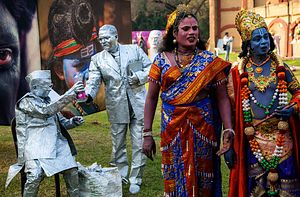People from the Bahurupiya tribe have traditionally done street performances as their main occupation, using the art of impersonation — painting their bodies to fake their identities. However, with new means of entertainment catching on in urban India, this art form faces extinction.
“They are struggling to survive and some have adopted alternative means of livelihood. We need to spread awareness to save this from vanishing,” said Vilas Janve, who recently curated a three-day event in New Delhi, where 70 Bahurupiyas were invited from across the country to perform.
This art flourished mainly in the states of Rajasthan, Gujarat, and West Bengal.
In English, Bahurupiyas are translated as “impersonators,” but they are much more than that. They are directors, script-dialogue writers, choreographers, musicians, and makeup artists who use satire, wit, humor, and banter – all in one.
“This is a narrative art, passed on from generation to generation, orally. My father taught me the nuances and I taught my sons the same,” said veteran artist Subrati, who is from the northern Rajasthan state. “And we never thought of doing anything else. This is our life, the sole mean of existence. As we roamed around throughout the year, we couldn’t send our children to school. They learned only to prepare colors and costumes, mythological stories, studying human behavior on the field. They did not study mathematics or science or literature in a classroom. So they practice the art, facing challenges of the modern times. Earlier, rulers loved the art and patronized it. Now it is for the government and society to decide whether the tradition survives or vanishes.”
Ironically, while the Bahurupiyas are finding it difficult to survive, others are embracing the art form. I met a cop, a banker, an educationist, a farmer, and a trader who had been practicing it as a hobby. But, as Subrati said, “They can put on make-up and costumes but that’s not all. Bahurupiyas internalize the character in their blood and soul, without which it is nothing but a fancy dress performance.”
Prabhat Singh is a journalist for StoriesAsia.












































